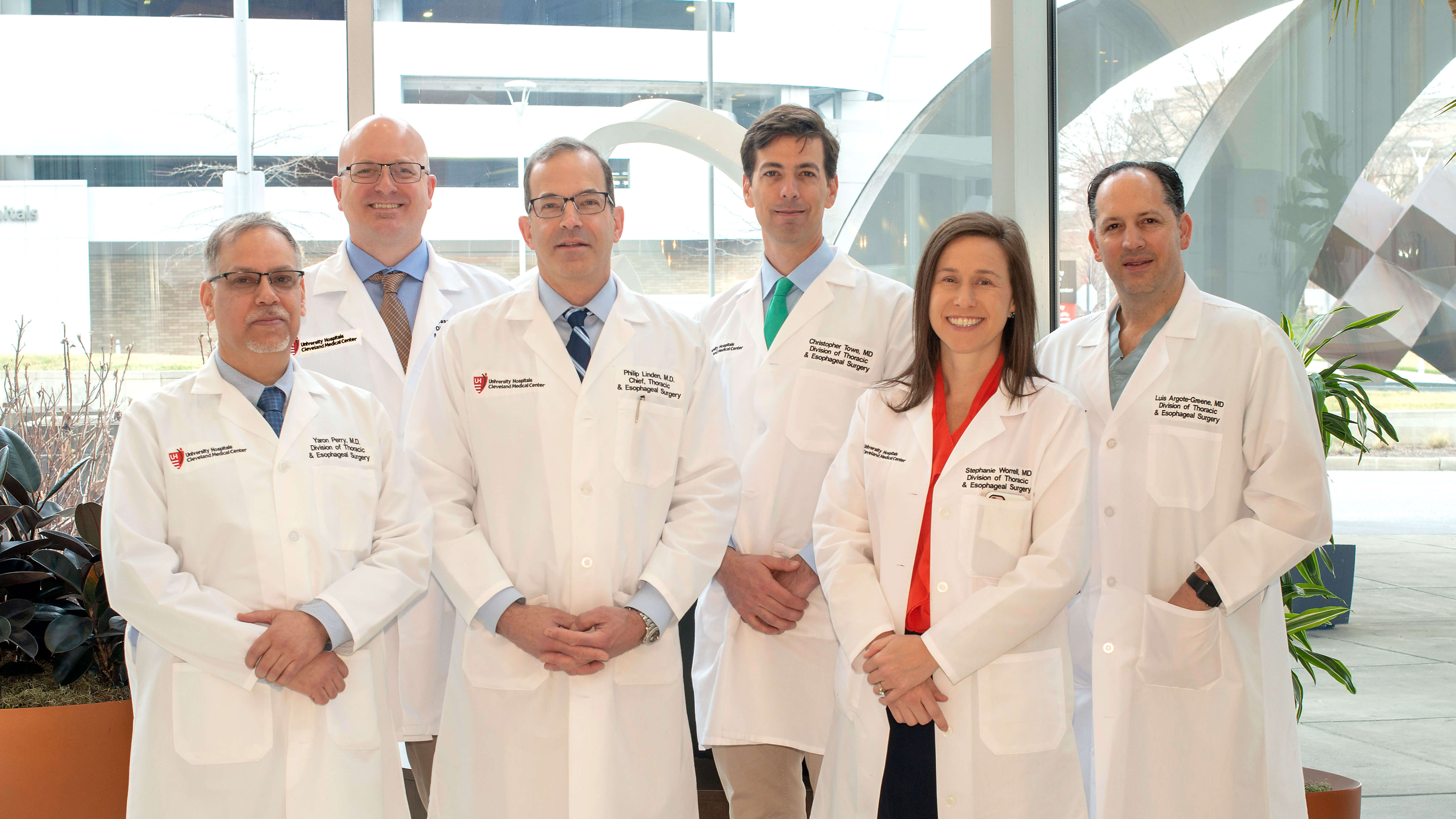Division of Thoracic & Esophageal Surgery Receives Highest Mark for Quality Outcomes
September 11, 2019
A top-notch surgical team for thoracic and esophageal cancer
Innovations in Digestive Health | Fall 2019
It’s official: The Division of Thoracic & Esophageal Surgery at University Hospitals is considered one of the top medical centers in the United States for lung and esophagus surgery.
The division recently earned a three-star rating from the Society of Thoracic Surgeons (STS) for its patient care and esophageal resection outcomes. STS also recognized UH to be in the top 10 percent of all major hospitals for lung surgery outcomes.
 From L to R: Drs. Yaron Perry, Jason Robke, Philip Linden, Christopher Towe, Stephanie Worrell, Luis Argot-Greene.
From L to R: Drs. Yaron Perry, Jason Robke, Philip Linden, Christopher Towe, Stephanie Worrell, Luis Argot-Greene.The rating signifies the highest category of quality and puts the division among the elite for general thoracic surgery in the United States and Canada. Historically, less than 10 percent of participants in the STS National Database receive a three-star rating.
“Over the last 10 years, we have built University Hospitals into a high-volume center,” says Philip Linden, MD, Chief of the Division of Thoracic & Esophageal Surgery, UH Cleveland Medical Center; and Associate Professor of Surgery, Case Western Reserve University School of Medicine. “We have maintained the highest quality as evidenced by our outcomes in lung and esophageal surgery.”
The STS General Thoracic Surgery Database (GTSD) contains nearly 600,000 general thoracic surgery procedure records and includes about 1,000 participating physicians. Participating physicians report 11 quality measures related to operative mortality, 90-day outcome, major morbidity, receipt of certain medications and other quality measures. STS scores participants in four categories and then combines those scores to calculate a composite score. STS issues star ratings based on whether participants perform better, worse or as expected.
“The STS database was established in 1989,” says Yaron Perry, MD. Thoracic and Esophageal Surgery, UH Cleveland Medical Center. “Everything is transparent. The data helps us get a better understanding of how we can perform better. Participants are highly specialized, so a high ranking is something to be proud of.”
“If a patient wants to know who has the highest rankings for esophageal surgery, STS makes information available to the public,” adds Stephanie Worrell, MD, Thoracic and Esophageal Surgery, UH Cleveland Medical Center. “Our patients can know they’re getting the highest quality thoracic and esophageal care at UH.”
Skilled Staff
The division’s three-star STS ranking and generally stellar reputation stem from a skilled surgical team supported by outstanding nursing and ancillary staff. “Our thoracic surgery team has been assembled from all over the nation,” says Dr. Linden. “Each surgeon is an expert in chest diseases, minimally invasive surgery and patient care.”
Dr. Linden focuses his surgical practice on minimally invasive chest surgery, lung and esophageal cancer, the treatment of emphysema, and high-risk thoracic surgery. A dedicated researcher, Dr. Linden received the STS Richard Clark Award in 2014 for the best database research project of the year.
Dr. Perry is a thoracic and esophageal surgeon with expertise in a variety of procedures related to cancer and other diseases and disorders. He’s a leader in minimally invasive esophageal surgery and robotic thoracic surgery. “Because recovery is much faster than with open surgery, robotic surgery won’t delay chemotherapy or radiation treatment,” Dr. Perry says.
Dr. Worrell’s area of focus is esophageal surgery. She offers minimally invasive procedures for gastroesophageal reflux disease (GERD), as well as for lung and esophageal cancer. Dr. Worrell performs traditional procedures, robotic surgeries and the LINX procedure for GERD.
These physicians, along with the rest of the six-person thoracic and esophageal surgery team, collectively perform more than 800 procedures a year. In the vast majority of cases, the surgeons use minimally invasive techniques such as video-assisted thoracic surgery (VATS) or robotic surgery. In cases where patients’ lungs are too weak to withstand surgery, physicians can opt for stereotactic radiosurgery technology.
The team excels in treating complex lung and gastroesophageal conditions, as well as caring for older adults and high-risk patients. For all conditions, the surgical team takes a multidisciplinary, collaborative approach to ensure the highest quality care.
Benefits of Transparency
In addition to guiding patients to top cardiothoracic surgeons, the STS National Database serves as a resource for member physician-researchers. Dr. Linden and Dr. Perry drew on STS data for manuscripts related to perioperative risk and postoperative complications, respectively. “Research in national surgical outcomes helps improve surgical outcomes everywhere,” says Dr. Linden.
Looking ahead, the Division of Thoracic & Esophageal Surgery expects to expand patient volume. Currently, thoracic surgery is offered at UH Cleveland Medical Center and University Hospitals Elyria, St. John’s Westshore, Ahuja, Parma, and Geauga Medical Centers.
To refer a patient for thoracic or esophageal surgery, call 216-553-1976.


